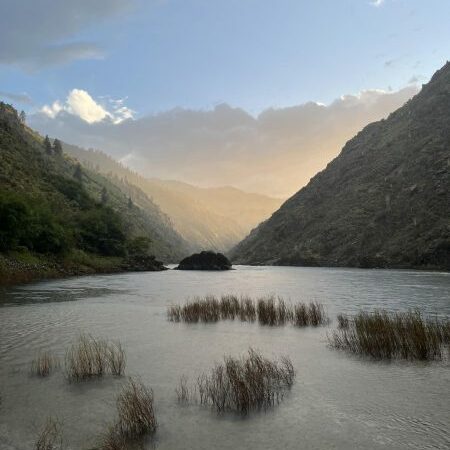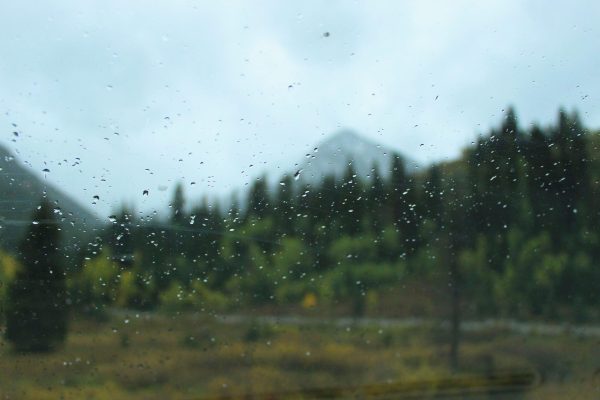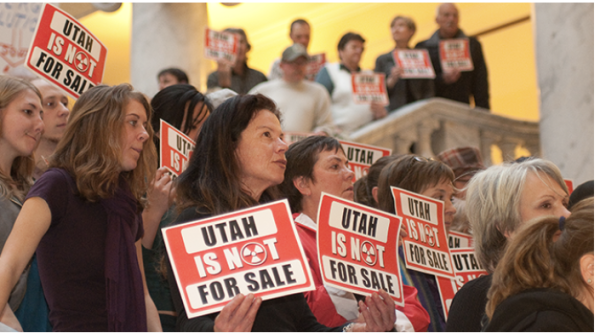The Hectic Habits of Hurricanes
Rain pelts the wet asphalt, creating puddles too big for the sewer drains to keep up with. Water runs like a small river down the road. Wind whips at tree branches and power lines, whirling in every direction and no direction all at once. Animals and humans take cover in whatever way they can. The seas rage with unparalleled ferocity, forming unforgiving waves that hit land with a seemingly personal vendetta.
Another storm works its way up the Atlantic ocean, through the Caribbean Sea, passing by the Gulf of Mexico, gaining strength. Winds get faster, rains get harder, sirens sound …
A hurricane forms.
While the effects of hurricanes are fairly foreign to Utahns and the majority of citizens inhabiting the other landlocked states in the United States, our country is no stranger to these powerful forces of nature. The University Corporation for Atmospheric Research (UCAR) Center for Science Education website gives great explanations of what hurricanes are and how they operate. These natural disasters known as hurricanes form over warm, tropical ocean waters due to disturbances in the atmosphere. These disturbances are called hurricanes in the Atlantic but are named typhoons or cyclones in other parts of the world due to the rotation of the storm in the hemispheres. The Coriolis effect causes the storms in the Northern Hemisphere to rotate counterclockwise but clockwise in the Southern Hemisphere.
As someone who is not particularly familiar with the workings of hurricanes, at least not on the specifics, it’s easiest for me to think of hurricanes as a mix of a thunderstorm and a tornado. Essentially, both hurricanes and tornadoes are formed from thunderstorms and carry the properties of them, but they have some important differences that set them apart.
Hurricanes are shaped fairly similarly to tornadoes. Both have an eye and storm walls, but the difference is that the cyclone in a hurricane doesn’t hit the ground like a tornado does. Hurricanes are basically multiple spinning thunderstorms over warm, tropical waters, while tornadoes are a wind vortex from hot, high-pressure air of a single thunderstorm over land. Different parts of the world experience different forms/forces of nature, and the Atlantic coast of the North American continent gets the lucky draw of experiencing hurricanes annually.
The reason the East Coast of the U.S. experiences hurricanes and tropical storms every year is because of the differences in water temperature of the Atlantic and Pacific oceans. The Gulf Stream along the East Coast is what provides this side of the country with higher water temperatures closer to shore that help maintain a hurricane. Hurricanes do in fact form in the Pacific Ocean; however, the ocean temperatures on the West Coast are considerably cooler than those on the East Coast, typically by more than 10 degrees. So when hurricanes form in the Northeast Pacific and head in the direction of the U.S., the storm’s strength is decreased when it hits the cooler water and diminishes the defining properties of a hurricane. Scientific American also states that “hurricanes in the northern hemisphere form at tropical and subtropical latitudes and then tend to move toward the west-northwest,” which puts the East Coast in the path of hurricanes a lot of the time. This doesn’t mean that every storm forming over the Atlantic Oc
ean is going to turn into a damaging hurricane, or even a hurricane for that matter.
Hurricanes are categorized by the Saffir-Simpson Hurricane Wind Scale to determine the types of damages that can occur from a hurricane due to the wind speeds of the storm. The scale runs from one to five, with five being the strongest hurricanes that cause the most damage. Category one hurricanes have winds between 74 and 94 mph with “very dangerous winds” that will cause some damage, while category five hurricanes have wind speeds of 157 mph or higher – which is insane – and will produce “catastrophic damage.” The remaining categories are somewhere in between these wind speeds and level of damages predicted. Categories three, four, and five are considered “major” hurricanes. The National Hurricane Center website provides the public with all the information needed for those wanting to know more about and prepare for hurricanes and offers resources for those affected.
The most recent hurricane that the Atlantic has experienced was Hurricane Ian in late September of this year. Hurricane Ian was a devastating storm that caused particularly severe damage across Jamaica, the Cayman Islands, Cuba, and southwestern Florida. It made landfall in Florida as a high-end category four hurricane. Hurricane Ian caused notable storm surges in the Naples and Fort Myers areas of Florida, with record-breaking heights. According to the National Hurricane Center, a storm surge is “an abnormal rise of water generated by a storm, over and above the predicted astronomical tides.” Storm surges are often the largest concern involved in a hurricane because they can be the greatest threat to life and property. They occur because of water being pushed towards the shore from the high winds of a hurricane. The destruction that storm surges cause are a real and present danger to those living in areas that are frequently affected by hurricanes, especially beachfront homes and buildings.
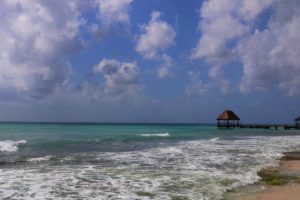
Just like snow storms are part of our culture here in the Salt Lake Valley, hurricanes are woven into the cultural fabric of the Atlantic coast of our continent.
Elliot Rogers, a friend from Tampa Florida, explained in depth the workings of hurricanes and how they tend to impact Florida. While I was in school learning about avalanches and earthquakes, he was learning about hurricanes and tropical storms. That’s not to say that most secondary schools don’t teach students at least a brief overview of all the different weather patterns, but we came to the conclusion that the location of where you live does have an impact on which natural occurrences you know more about.
“Typically, if it reaches a category three, you’ll start seeing the school districts do hurricane days, and as a Florida kid, we treat it like a snow day,” Rogers said.
The difference between hurricane days and snow days is not only the catastrophic precipitation and winds, but Rogers also explained that the reason these are given is so that the students can go home to their families and help prepare for the storm. This involves going to the store to get supplies, boarding up windows on houses, and sometimes even evacuating to safer areas further inland if people live close to the water.
So I think I’ll stick to snow days for now. They seem a bit more relaxing.
Rogers also talked about how Florida does a really good job at preparing before a storm hits, and something that I never would have guessed is that Disney World is a major player in this preparation. He explained that Disney World, specifically its parking lot, is one of the locations with the highest elevation in the state because of its concrete foundation. This is helpful when dealing with hurricanes because the government will bring in electricians, telecommunications, rescue teams, plumbers, and other special forces from neighboring cities and sometimes states to set up in the elevated parking lot and wait on standby to be sent to “dead zones” or areas that have been majorly affected by a hurricane. This preparation is key in helping get cities back up and running as soon as possible after a hurricane hits.
As a Florida resident, Rogers has experienced his fair share of hurricanes, but like many others, the worst hurricane that he said he has lived through was Hurricane Katrina. It started its rampage across the southern U.S. in late August of 2005. This hurricane is stated on record as being “one of the most devastating hurricanes in the history of the United States.” It is also the most deadly hurricane to hit the U.S. since 1928, totaling approximately 1,200 reported deaths.
While Hurricane Katrina is known as being the worst hurricane in the U.S. in our lifetime, Hurricane Wilma has a similar reputation in the Yucatan Peninsula of Mexico. Hurricane Wilma occurred in the month of October 2005 as well. Though Wilma also hit Florida, the southernmost part of Mexico bore the brunt of its force. Like Hurricane Ian, Hurricane Wilma was a slow-moving hurricane, which meant greater danger and destruction.
Slow-moving does not mean slow wind speeds, however. Hurricane Wilma hit the island of Cozumel and then the northeastern part of the peninsula (Cancun and Playa del Carmen area) at a category four, meaning wind speeds between 130 – 156 mph. It hit Florida at only a category two.
I visited Playa del Carmen, Mexico in October for fall break and I got to talk to some of the locals about their experience with hurricanes and gain insight into how they affect the county. It was a really awesome experience – a little stressful since I had to conduct the interviews in Spanish, which I am by no means fluent in, but it was great practice – talking with these locals and hearing their stories and views of hurricanes.
All of the people that I talked to about hurricanes gave simila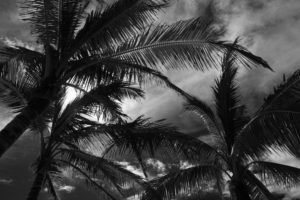 r responses, all saying that hurricanes are just part of the culture in the Yucatan Peninsula of Mexico. On average, hurricanes hit Mexico about 18 times a year. However, it’s not often that they experience “strong” hurricanes, mostly just category one or two with a lot of rain. None of the locals seem to view hurricanes as much of a problem, since the hurricanes that are mostly hitting the areas they are living in aren’t big enough to cause too much damage. They said as a country they prepare pretty well and that low-category hurricanes are just so common, it doesn’t seem to faze them.
r responses, all saying that hurricanes are just part of the culture in the Yucatan Peninsula of Mexico. On average, hurricanes hit Mexico about 18 times a year. However, it’s not often that they experience “strong” hurricanes, mostly just category one or two with a lot of rain. None of the locals seem to view hurricanes as much of a problem, since the hurricanes that are mostly hitting the areas they are living in aren’t big enough to cause too much damage. They said as a country they prepare pretty well and that low-category hurricanes are just so common, it doesn’t seem to faze them.
Everyone that I talked to, though, did reiterate that Hurricane Wilma was the worst hurricane that they have experienced in Playa del Carmen.
As I was collecting information for this story, I was reminded of how well we as humans adapt to our surroundings and experiences. The people who experience hurricanes the most, those living in Florida and Mexico, aren’t worried about the storms unless they get really bad. The same goes here with blizzards and snowstorms. It’s just so interesting and cool that depending on the environment we live in, certain aspects of life, like weather and natural disasters, are either completely foreign and concerning to us, or something that is just intertwined with our existence.
It’s wild that the unpredictability of these storms reflect the unpredictability of life, just in the most intense ways. So whether it’s the hurricanes, tornadoes, earthquakes, or blizzards of this life (actual or metaphorical), sometimes all we can do is ride out the storm and wait for it to pass.
The post The Hectic Habits of Hurricanes appeared first on Wasatch Magazine.
Source: https://wasatchmag.com/the-hectic-habits-of-hurricanes/



